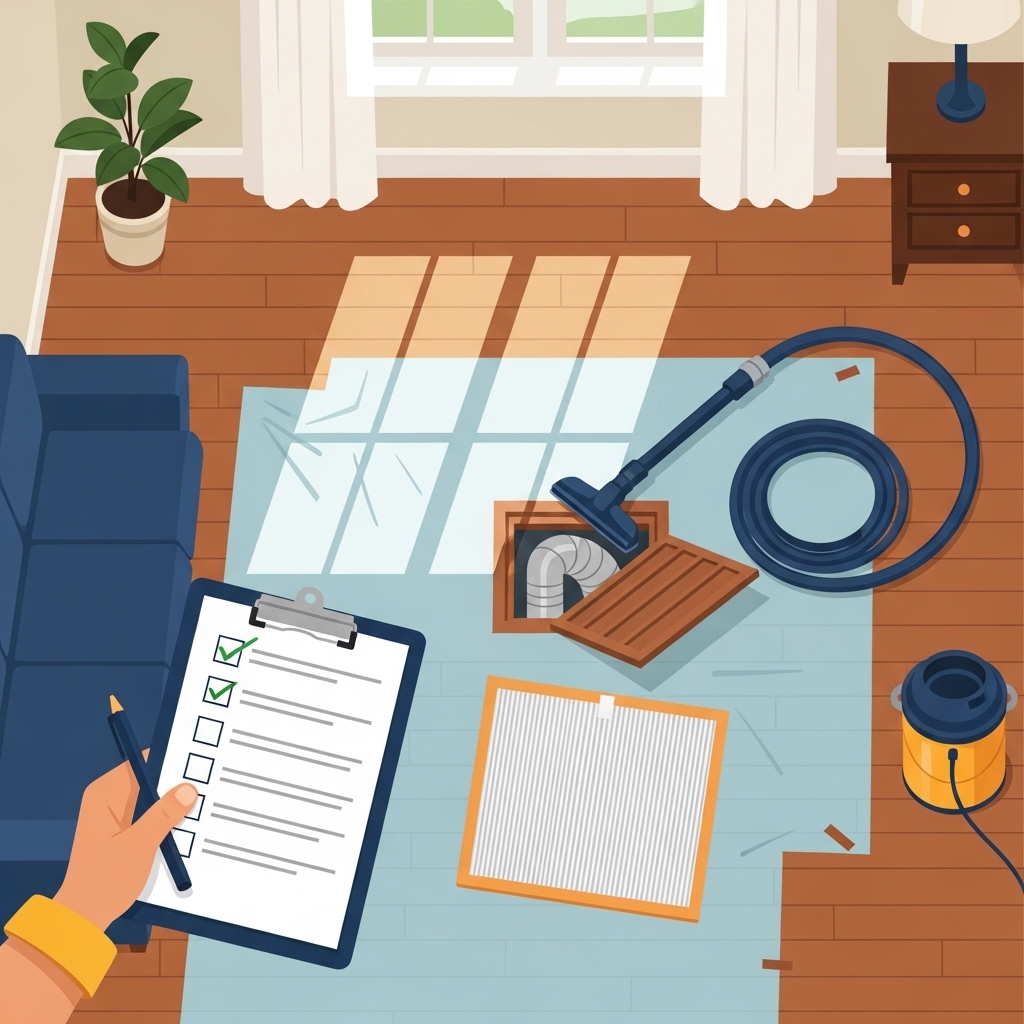A structured plan helps New Jersey homeowners get the most from air duct cleaning. From coastal humidity to tree pollen and leaf debris, the Garden State’s seasons present ongoing challenges for HVAC systems. Use the following checklist to prepare your home, evaluate providers, and maintain cleaner ducts all year. If you have not scheduled air duct cleaning in several years, this guide makes the process easier and more effective.
Pre-Appointment Planning
- Identify problem areas: Note rooms with poor airflow, dust accumulation, or odors.
- Gather HVAC details: System age, filter size, and recent service history.
- Decide on timing: Many homeowners choose spring or fall between peak seasons.
- Confirm access: Clear space around the air handler, returns, and supply registers.
- Secure pets: Plan for doors opening and equipment staging.
Provider Vetting Checklist
- Ask how negative pressure and agitation are used to remove debris.
- Request a written scope listing supply and return trunks, registers, and components.
- Confirm how access ports are created and sealed after the job.
- Discuss protection: Floor coverings, vent sealing, and dust control steps.
- Review documentation: Before-and-after photos and a service summary.
When comparing bids, favor clarity over vague offers. Ask each company to describe their workflow for professional air duct cleaning, how they protect sensitive duct materials such as flex, and how they handle sanitation only when justified.
Homeowner Preparation Checklist
- Move furniture or fragile decor away from vents.
- Replace the return grill screws if stripped or missing.
- Have the correct filter ready for post-cleaning installation.
- Note special concerns: Allergies, recent renovations, or moisture issues.
- Plan for parking and equipment access from the driveway or curb.
On-the-Day Walkthrough
- Confirm scope: Review which trunks, branches, and components are included.
- Point out issues: Show technicians rooms with uneven airflow or odors.
- Protect surfaces: Ensure floor protection and register sealing are in place.
- Power down: The air handler is shut off and locked out for safety.
- Access creation: Technicians open panels or ports as needed.
- Negative pressure: The vacuum is connected to the trunk to pull debris.
- Agitation: Brushes and air whips dislodge dust from interior surfaces.
- Component cleaning: Blower compartment and returns addressed per scope.
- Verification: Registers are reinstalled, access points sealed, and airflow checked.
Post-Cleaning Checklist
- Install a fresh filter of the correct MERV rating for your system.
- Walk through the home: Check that registers are aligned and secure.
- Review photos and notes: Confirm all areas in scope were addressed.
- Ask for recommendations: Sealing gaps, improving filtration, or addressing moisture.
- Set reminders: Schedule filter changes and a future inspection.
Seasonal Tips for New Jersey Homes
- Spring: Pollen peaks—keep windows closed on high-count days, run filtration continuously, and vacuum registers.
- Summer: Manage humidity; high moisture encourages microbial growth if condensation forms.
- Fall: Leaves and debris near outdoor intakes should be cleared to reduce infiltration.
- Winter: Heating cycles move dry dust—monitor for static and maintain filter changes.
Filter Strategy and Air Sealing
Choose filters that balance capture efficiency and airflow. Overly restrictive filters can strain the blower, while too-low capture ratings allow more dust into returns. Seal return-side leaks and around the air handler to reduce unfiltered air infiltration from attics or basements. A well-sealed return path reduces dirt entering the duct system in the first place.
Common Pitfalls to Avoid
- Chasing odors without addressing moisture sources.
- Accepting vague “whole house” specials without itemized scope.
- Skipping documentation—photos help verify results.
- Forgetting the blower and return side—key areas for buildup.
- Using chemicals as a substitute for source removal.
Maintenance Checklist for Cleaner Ducts Year-Round
- Change filters on schedule based on manufacturer guidance and household conditions.
- Vacuum registers and returns gently to prevent dust recirculation.
- Control humidity with dehumidifiers or HVAC settings to stay within comfortable ranges.
- Address water leaks immediately and dry any wet materials.
- Schedule periodic HVAC inspections to catch issues early.
Frequently Asked Questions
Q: How long does a typical cleaning take? A: For most single-family homes, several hours, depending on size and contamination.
Q: Do I need to leave the house? A: Not usually. Technicians will need access to all rooms with vents and the air handler.
Q: Is there a mess? A: Proper containment and negative pressure minimize dust; crews should protect floors and reseal access points.
Q: Will cleaning fix uneven airflow? A: It can help by removing restrictions, but duct design, balancing, or equipment issues may also play a role.
Q: How often should I clean? A: Many homes benefit every three to five years, adjusted for pets, allergies, renovations, and overall dust levels.
Ready to Put Your Checklist Into Action?
With a clear plan, you can evaluate providers confidently, prepare your home efficiently, and maintain cleaner ducts long after the appointment. Start by noting your priorities, verifying process and documentation, and booking a convenient time. When you are ready, schedule an expert air duct cleaning service and enjoy fresher air, better airflow, and peace of mind in your New Jersey home.

